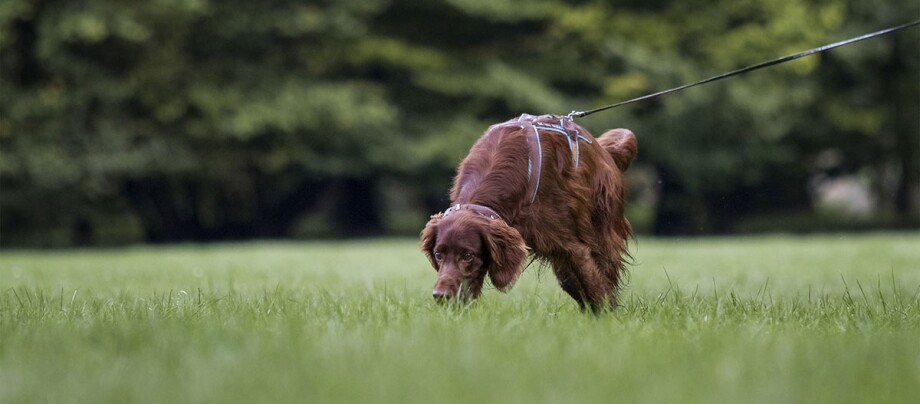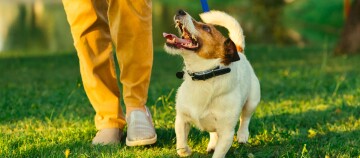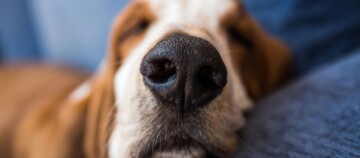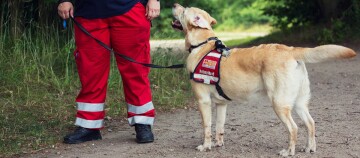Mantrailing - Naturally Exhaust, Challenge and Encourage Your Dog
07.10.2022 - Reading time: 4 minutes

Dogs have the best noses in the world. They have around 250 million olfactory cells inside which allow them to receive smells and process complex information. In comparison, humans have about 25 million receptors so our noses detect barely anything and can only decipher basic information from smells.
Dogs, on the other hand, not only smell better than humans – they also smell spatially. It is hardly surprising that about 10 per cent of their brain (one percent in humans) is occupied with processing olfactory information. Mantrailing is a dog sport that matches these olfactory abilities brilliantly, and that naturally exhausts, challenges and encourages the dog.
What is mantrailing?
Mantrailing is a method originating from the USA to track missing or wanted persons (the “man” in question) with the help of sniffer dogs. It is based on the dog’s ability to follow a specific scent trail for kilometres. Mantrailing is primarily used by the police and rescue services and has its origins in these areas.
While in conventional tracking dogs follow a trail left by animals, people or objects on the ground, in mantrailing they are trained to become specialists. Here, the so-called mantrailers (people-tracking dogs) learn to smell a specific human scent out of all the other scents and to recognise its trail.
It is fascinating how mantrailers can sniff the scent mark in the air even days later. Some experts are convinced their mantrailers can follow a human scent trail even after the person they are looking for has driven away in the car.
Mantrailing is a natural exercise for any pet dog and is also a fascinating activity to do with your own dog. It is therefore no wonder that it is becoming increasingly popular as a dog sport in the private sector.
How does mantrailing work?
Every person has a unique individual odour, which is composed of breath, diverse body vapours and gases from the body’s own metabolic processes. This is augmented by shed hairs and bacteria that colonise the human body. In addition to this cocktail of scents, each person loses about 1 to 1.5 grams of tiny skin flakes per day, which leave a trail in themselves.
Dogs trained in mantrailing learn to “read” these distinctive scents, to distinguish them from other smells and to follow them specifically. Based on the individual bacteria that disintegrate our skin and hair cells in a biochemical process, mantrailers are even able to distinguish between new and old trails. A properly trained dog follows the fresh trail and ignores the old one. In addition, dogs are capable of so-called stereo smelling, or spatial smelling. They perceive the smells individually in each nostril and can assign the direction from which they come.
In mantrailing, the dog is calibrated to a single scent sample. On the trail, it then probes those scent particles in its environment that correspond to the scent and “interprets” them in terms of age, direction and intensity.
Which dog is suitable for mantrailing?
Whether a young puppy of nine months or a 13-year-old senior dog – mantrailing is suitable for almost every dog. For professional training, however, your dog should be trained as young as possible, which you can start as a game when still a puppy.
Requirements for the dogs
- Since tracking can take hours and the intensive sniffing of the environment is very strenuous for dogs, your dog should have a certain basic level of fitness. Nevertheless, private mantrailing is also suitable for dogs with a handicap.
- Although flat-faced dog breeds such as Pugs, Pekinese and Bulldogs smell just as well as their contemporaries with longer noses, they get into respiratory distress more quickly and should not participate in mantrailing.
- Predestined for mantrailing, on the other hand, are breeds with hunting qualities, especially bloodhounds, which were originally bred to follow a blood trail.
- Many different dogs benefit from mantrailing. Even insecure, fearful four-legged friends become accustomed to everyday noises in training and shed their fears by focusing on a task. Success in training also strengthens sensitive and submissive dogs by building their self-confidence.
How can I teach my dog mantrailing?
Before you start training with your dog, you have to go to school yourself. Mantrailing requires particularly close cooperation between owner and dog. Therefore, it is absolutely necessary that you correctly interpret all the signals that your dog shows on the trail. This includes the smallest changes in posture, expression of the tail, movement of the ears and flews. A good handler also needs to understand how dogs smell and process this information in the brain.
Steps to teaching mantrailing
- Your dog is first taught to focus on its task. This also includes desensitising the dog to other stimuli in the environment (horns, ringing noises, clanging, loud voices, etc.)
- Next, you teach your dog to focus on the specific scent of the person in the area and to follow the scent trail continuously. At first, this is only done at short distances and with a lot of encouragement for the animal.
- Only when the dog-human team has really grown together do further exciting levels of difficulty and hurdles in tracking take place.
What do I need for mantrailing?
Visit several mantrailing schools before you decide on a trainer. Since the training to become a mantrail instructor is not subject to any special examination in Germany, the quality of the courses offered may differ greatly. Make sure that your dog is not overwhelmed or frustrated by the level of training.
Equipment for mantrailing
- 5 to 10 metre long drag leash
- Special chest harness (search dog harness) reserved exclusively for training
High-visibility clothing - in cold weather: warm dog clothing
- Scent samples (T-shirt, socks, cap, etc.) packed in resealable plastic bags
Food (as a reward) - Water for the dog
Above all: sniffing the trail should be fun for the dog (and for you)!


